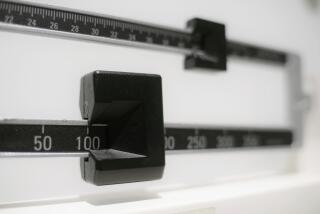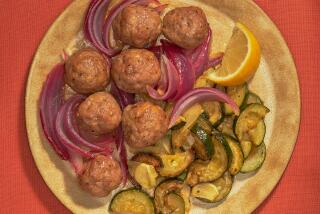The Craze to Graze: How to Snack With Nutrition in Mind
- Share via
There is nothing written in stone about eating three meals a day. Anthropologists tell us that this concept was born out of cultural, rather than nutritional, necessity.
Back in the “good old days,” when men were doing hard physical labor from dawn to dusk and the women worked in the home and cooked all day, it seemed to make perfect sense. One meal before work, another one to hold you through the day and the last one when your work was finished. There are some mothers (we won’t mention any names, but you know who you are) who raised this notion to a tyrannical level, building their lives around preparing family meals at certain hours and discouraging everyone from eating between meals. Snacking was considered undisciplined and simply was not allowed.
As Puritan values relaxed and food became more plentiful, snacking lost some of its stigma, but the custom of having three meals a day continues as the norm, even though for many of us the most strenuous work we carry out is to reboot the computer from time to time. In exchange for hard, physical labor, we often work long and strange hours, balancing careers and family responsibilities, and we need to have a lot more flexibility in our eating schedules.
Eating mini-meals throughout the day, or grazing, is now an accepted and sensible way to ensure that you get the calories and nutrients you need. This can be especially beneficial for children, teenagers and the elderly, who for various reasons often may not be able to eat in the more traditional way.
*
The secret is to make sure the snacks you eat are not high-calorie, high-fat, low-nutrient foods. This is easy to do if you skip the potato chips and candy bars and follow the same dietary guidelines that you do with your regular meals. If you’re watching your weight, grazing may be a good alternative to three big meals a day. Just make sure you graze instead of, and not in addition to, meals.
Here are some ideas that may help you incorporate nutritious snacks into your diet.
* If you don’t have time to fuel up with breakfast, choose some grain-based snacks like whole wheat bagels or fat-free crackers and pair them up with yogurt or cottage cheese. Pack a snack to take with you to work or school. That way, even if you don’t have time to eat on your way out of the house, you can snack when you get where you’re going. And be sure to include boxed drinks like tomato juice or 100% fruit juice blends.
* If you don’t have time for lunch, or you need a midday pick-me-up, stash a supply of healthy snacks in your desk, in the glove compartment of your car, in your gym bag, in your purse. Try pretzel sticks, individual packs of cereal, baby carrots or fresh fruit.
* When you do your shopping, buy big, economy-size packages and divide the contents into individual plastic bags that you can store in the pantry for easy pick-up. Do the same with fresh fruits and vegetables in the refrigerator. Grabbing a healthy snack late in the afternoon may prevent you from doing anything stupid when the hunger pangs strike and dinner is several hours away.
Need some new ideas for small meals and healthy snacks? Here are a few we’ve accumulated.
* Try something entirely new, like edamame (soybeans in the pod). You should be able to buy these at most Asian markets and health-food stores. Put the soy pods in boiling salted water and cook for two to five minutes. Drain, cool and serve. To eat them, put the pod in your mouth and strip the beans out with your teeth. Then discard the pod. Even kids will love these crunchy treats.
* Marinate leftover vegetables in low-calorie salad dressing and eat cold.
* Combine plain yogurt, 3 tablespoons of low-calorie jam, one-fourth teaspoon of cinnamon and 1 teaspoon of lemon rind. Use as a dip with fresh fruit chunks.
* Mix water-packed tuna, plain yogurt, onion, celery, cucumber, pepper, dry mustard and lemon juice or vinegar. Spread on crackers or Melba toast.
* Marinate thin cucumber slices and thin red bell pepper slices in rice wine vinegar and a little sugar. Add chopped dry-roasted peanuts. Serve cold.
* Make a mini-pizza by putting a tomato slice or tomato sauce on a bagel chip, English muffin, Melba toast or pita bread. Spread lightly with olive oil, sprinkle with Italian seasoning, add any kind of vegetables and top with part-skim mozzarella. Put under the broiler to melt the cheese.
* Use whole wheat pita bread to make a pocket salad. Cucumber, onion, lettuce, tomato and low-fat dressing make a great combination.
* Create an instant low-fat frozen treat. Combine 2 cups of frozen (unsweetened) fruit, 1 cup skim or low-fat milk and 2 to 4 tablespoons of sugar (optional). Place in the blender and whirl until smooth. Serve immediately as soft “ice cream” or pour into plastic cups and freeze for 1 hour.
Have fun grazing and snacking. Make it a chance to be creative and pat yourself on the back for every healthy new idea you get.
More to Read
Eat your way across L.A.
Get our weekly Tasting Notes newsletter for reviews, news and more.
You may occasionally receive promotional content from the Los Angeles Times.







